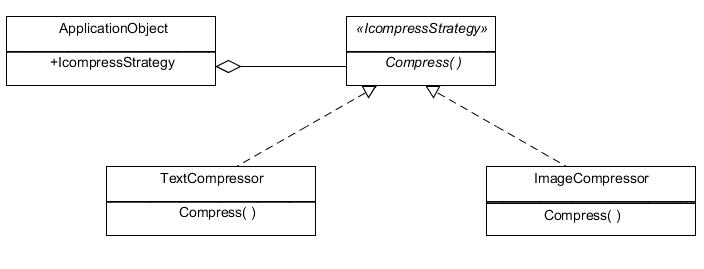CSC/ECE 517 Fall 2010/ch3 3h az
Objective
Objective of this Wiki Chapter is that the reader should be get an overview of
- Strategy pattern, when and how to use strategy pattern.
- Implementation of strategy pattern in Dynamic, Static object oriented language by going through our example.
Introduction
A design pattern is a general reusable solution to a commonly occurring problem in software design. Strategy Pattern in one such pattern which helps to use multiple algorithms interchangeably to reduce multiple conditions statements. This helps in making the code more maintainable.
The intent of Strategy pattern would be to define a family of algorithms, encapsulate each one, and make them interchangeable. Strategy lets the algorithm vary independently from clients that use it. As an algorithm evolves to handle more and more situations, it can become very complex and difficult to maintain, Strategy pattern can be used to resolve this situation.
When to use Strategy Pattern
- Many related classes differ only in their behavior.
- You need different variants of an algorithm. For example, defining different algorithms based on space-time tradeoffs.
- A class defines many behaviors, and these appear as multiple conditional statements in its operations.Instead, move related conditional branches into their own Strategy class.
Generic Implementation and participant of Strategy pattern:
Strategy:
- Declares an interface common to all supported algorithms. Context uses this interface to call the algorithm defined by a ConcreteStrategy.
ConcreteStrategy:
- Implements the algorithm using the Strategy interface.
Context:
- Is configured with a ConcreteStrategy object
- Maintains a reference to a Strategy object
- May define an interface that lets Strategy access its data.
Illustration of Strategy pattern through real world example
To illustrate strategy pattern let’s consider this example of basic file transfer scenario, where we want to compress the file before transmission. File compression can be achieved by different algorithms for different types of file. Image files and text files can be compresses by different algorithm, here we would like demonstrate how this algorithm can be encapsulated and helps in selecting the algorithms without the conditional statements.
The following UML class diagram captures the scenario we are illustrating:

ApplicationObject would be having instance of IcompressStrategy. IcompressStrategy is the common interface and defines generic algorithmic method which would be extended by various classes which implements the algorithm. Having instance of interface in Applicationobject would make possible for selecting different algorithms interchangeably.
Based on the File type, we can instantiate the right kind of Compressor. Here we can also have Factory method which helps in deciding the right kind of subclass of IcompressStrategy to instantiate.
Implementation of Strategy pattern in Dynamic Object Oriented language
Ruby Code which makes use of o-o principle to illustrate strategy pattern
class CompressContext
def initialize(compression_strategy)
self.class.send :include, compression_strategy
end
end
module TextCompresser
def compress
puts 'Compression the text file'
end
end
module ImageCompresser
def compress
puts 'Compression the image file'
end
end
class Main
def self.compressandSend(*args)
file = args[0]
#=> compressing text file
compressType = CompressContext.new(TextCompresser)
compressType.compress
#=> compressing image file
compressType = CompressContext.new(ImageCompresser)
compressType.compress
end
Main.compressandSend("filepath")
end
Ruby Code which makes use of blocks to illustrate strategy pattern
class CompressContext
def initialize(&strategy)
@strategy = strategy
end
def compress
@strategy.call
end
end
#=> Compress Text File
textCompresser = CompressContext.new { puts 'block which can be used for text compression' }
textCompresser.compress
#=> Compress Image File
imageCompresser = CompressContext.new { puts 'block which can be used for Image compression' }
imageCompresser.compress
Implementation of Strategy pattern in Static Object Oriented language
Java Code to demonstrate strategy Pattern implementation
// Main Method of Context Class..
File file = getFile(); //get file path..
Compresser ci = CompresserFactory.getCompresser( file.type() );
ci.performAction();
// implementations:
interface Compresser {
public void compressAction();
}
class ImageCompressStrategy implements Compresser {
public void compressAction() {
// Use Standard JPEG compress algorithm ....
}
}
class TextCompressStrategy implements Compresser {
public void compressAction () {
// use Haufman text compress algorithm.
}
}